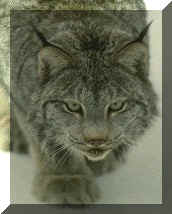


Lynx
Status: Waiting to
be listed as threatened under the Endangered Species Act.
Description: Pale,
silky fur, brownish-gray in color and face ruff, long black ear tufts, and a black-tipped,
bobbed tail. The bobbed tail, along with fur covered foot pads and long legs, make it easy
for the lynx to run through snow.
Size: Shoulder
height: 19-24 inches, length: 36-40 inches, weight: 22-30 pounds. Males are larger than
females.
Habitat: Likes the
density of coniferous forests and swamp areas where its coloring allows the lynx to be
camouflaged from its prey.
Range: Historic
range has been throughout the forests of Alaska and Canada. In the the lower 48 states, it
ranged into northwestern and northeastern states of Washington, Oregon, Idaho, Montana,
Colorado, northern Minnesota, Wisconsin, New York, and the New England states. Today the
lynx can be found only in western Montana, parts of northern Idaho, northeastern
Washington, Canada and the Adirondack Mountains of New York state.
Food Source:
Snowshoe hares make up the majority of the lynx's diet, but they will also eat rodents,
birds and fish.
Behavior: Lynx are
solitary, nocturnal animals who often travel up to twelve miles in a single night
searching for food. They stalk and ambush their prey by sight and sound, sound being most
important. It is thought that their long ear tufts are useful in detecting the movements
of their prey. Lynx are also excellent swimmers and climbers.
Reproduction:
Litters of two or three young are born in the mid to late spring after a gestation period
of 9-10 weeks. Nursing lasts for about five months, although kittens will begin to eat
some meat at one month. The young stay with the mother until the winter mating season
(February-March).
Population: Where
lynx still occur, their numbers often increase and decrease along with their primary prey,
the snowshoe hare.
Longevity: 10-15
years.
Survival Threats:
Habitat destruction is the primary problem for the lynx today. Man's continuous
development of much of its territory has made it more difficult for the lynx to thrive.
The fur trade also poses a serious threat to the survival of the lynx.
Legal Protection:
CITES, appendix II. Appendix II listed species can only be traded commercially if it does
not harm their survival.
